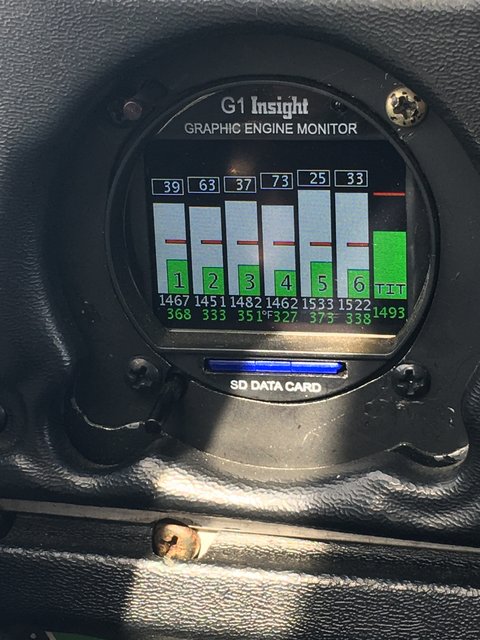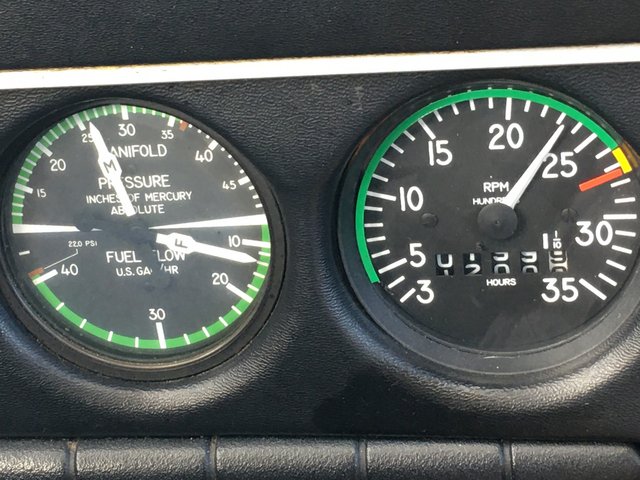Hi!
I'm still very new, 75 hr pilot. 20 hrs in my plane, a PA-32-301T Saratoga Turbo. I'm starting IFR training with my CFII, while in cruise, I'm working on running LOP. I have read a ton of Mike Busch's stuff, and watched all the videos I could find. My CFII doesn't know anything about running LOP, though, so I'm on my own, and would love extra eyes checking my work.
In cruise today at 8000 feet, 65% power setting by the POH, as below, with the book ROP fuel flow. I have a G1 Insight engine monitor. It shows CHT in the green, EGT in the white. Reading the manual for the engine monitor, it records your max EGT and as you move away from that, it gives you the boxed number up top which tells you how far below max EGT you are for each cylinder. At 65% power, I pulled from ROP slowly through peak EGT until I was lean, and continued to lean till the engine started fishbiting (running rough), and I enrichened just enough to run smooth. The settings below are what I got.
Please note this is a TIO-540 Lycoming, so I am looking for CHT below 400 per Mike Busch's recommendations, so I believe all my CHTs were extremely conservative by Mike Busch's literature.


I have a really big spread on how far off peak I am for each cylinder. I haven't figured out what my GAMI spread is. I think the above settings are great, and very safe, as the cylinder closest to peak EGT is 23 degrees LOP. I also think at 65% power, I'm not murdering the engine to pull slowly through peak EGT, but obviously I wouldn't do this normally, I only did it because I'm still learning and watching what the monitor does.
I'm also not sure, would you call the above 25 LOP, or 73 LOP? Are you looking at best cylinder? Worst? Middle?
After awhile we got a descent or something and I changed all my settings. When I got back to the same RPM and MP settings, I tried the exact same procedure, but I couldn't get the same numbers on the engine monitor. My spread was basically 23 degrees LOP to 4 degrees LOP, so most of my cylinders were very close to peak (not in order, 4,7,12,13,15,23). I could maybe lean a bit more, but my lowest temp cylinder was 60 LOP, with the hottest around 20 and I kept getting fishbites. My cylinder temperatures were pretty similar to the above pics. I believe (4,7,12,13,15,23) was too close to peak EGT to be safe based on leaning by EGT, but if you take Mike Busch's advise and my worse CHT is 370, I should be just fine even that close to peak EGT.
I'm a bit confused why I couldn't lean better the second time around, may just need a finer touch on the knob. I'm also very unsure of whether running close to peak EGT was safe. If you look at the redfin pics from the Advanced Pilot Seminars lectures that Mike Busch throws out, at 65% power, there is still a red zone around peak EGT, but if you look only at CHT per what Mike Busch says, I should be just fine because my CHTs are all WAY below 400.
I'm still very new, 75 hr pilot. 20 hrs in my plane, a PA-32-301T Saratoga Turbo. I'm starting IFR training with my CFII, while in cruise, I'm working on running LOP. I have read a ton of Mike Busch's stuff, and watched all the videos I could find. My CFII doesn't know anything about running LOP, though, so I'm on my own, and would love extra eyes checking my work.
In cruise today at 8000 feet, 65% power setting by the POH, as below, with the book ROP fuel flow. I have a G1 Insight engine monitor. It shows CHT in the green, EGT in the white. Reading the manual for the engine monitor, it records your max EGT and as you move away from that, it gives you the boxed number up top which tells you how far below max EGT you are for each cylinder. At 65% power, I pulled from ROP slowly through peak EGT until I was lean, and continued to lean till the engine started fishbiting (running rough), and I enrichened just enough to run smooth. The settings below are what I got.
Please note this is a TIO-540 Lycoming, so I am looking for CHT below 400 per Mike Busch's recommendations, so I believe all my CHTs were extremely conservative by Mike Busch's literature.


I have a really big spread on how far off peak I am for each cylinder. I haven't figured out what my GAMI spread is. I think the above settings are great, and very safe, as the cylinder closest to peak EGT is 23 degrees LOP. I also think at 65% power, I'm not murdering the engine to pull slowly through peak EGT, but obviously I wouldn't do this normally, I only did it because I'm still learning and watching what the monitor does.
I'm also not sure, would you call the above 25 LOP, or 73 LOP? Are you looking at best cylinder? Worst? Middle?
After awhile we got a descent or something and I changed all my settings. When I got back to the same RPM and MP settings, I tried the exact same procedure, but I couldn't get the same numbers on the engine monitor. My spread was basically 23 degrees LOP to 4 degrees LOP, so most of my cylinders were very close to peak (not in order, 4,7,12,13,15,23). I could maybe lean a bit more, but my lowest temp cylinder was 60 LOP, with the hottest around 20 and I kept getting fishbites. My cylinder temperatures were pretty similar to the above pics. I believe (4,7,12,13,15,23) was too close to peak EGT to be safe based on leaning by EGT, but if you take Mike Busch's advise and my worse CHT is 370, I should be just fine even that close to peak EGT.
I'm a bit confused why I couldn't lean better the second time around, may just need a finer touch on the knob. I'm also very unsure of whether running close to peak EGT was safe. If you look at the redfin pics from the Advanced Pilot Seminars lectures that Mike Busch throws out, at 65% power, there is still a red zone around peak EGT, but if you look only at CHT per what Mike Busch says, I should be just fine because my CHTs are all WAY below 400.




